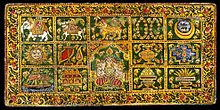| Trishala | |
|---|---|
| Mother of last Tirthankara | |
 Kalpa Sūtra miniature of Princess Trishala (bottom) and her auspicious dreams, c. 1472. Kalpa Sūtra miniature of Princess Trishala (bottom) and her auspicious dreams, c. 1472. | |
| Other names | Priyakarini , Videhadatta |
| Genealogy | |
| Parents |
|
| Siblings | Chetaka |
| Spouse | Siddhartha |
| Children |
|
| Dynasty | Licchavi clan (by birth) Ikshvaku dynasty (by marriage) |
Trishala, also known as Videhadatta, Priyakarini, or Trishala Mata (Mother Trishala), was the mother of Mahavira, the 24th Tirthankara of Jainism, and wife of the Gaṇa Mukhya, Siddhartha of Kundagrama, of present-day Bihar. She finds mention in the Jain texts.
Life
Trishala was born as a princess of the Licchavi Republic. The Jain text Uttarapurāṇa details the life of all Tirthankaras and other Salakapurusa. It is mentioned in the text that Consul Chetaka of Vaishali had ten brothers and seven sisters. His sister Priyakarini (Trishala) was married to Siddartha. As per Shvetambara texts and Indologist Hermann Jacobi, Vardhamana Mahavira's mother Trishala was sister of Consul Chetaka. His third wife, Kshema, was a daughter of the chief of the Madra tribe of Punjab. Trishala had seven sisters, one of whom was initiated into the Jain monastic order while the other six married famous kings, including Bimbisara of Magadha. She and her husband Siddhartha were followers of Parshvanatha, the 23rd Tirthankara according to the second chapter of the Śvētāmbara Ācārāṅga Sūtra. According to Jain texts, Trishala carried her son for nine months and seven and a half days during the 6th century BC. However, Shvetambaras generally believe that he was conceived by Devananda, the wife of a Brahmin Rishabhadatta and the fetus was transferred to Trishala's womb by Indra because all Tirthankaras have to be Kshatriyas. All this is mentioned in the Shvetambara text, Kalpasutra, which is primarily a biography of the Tirthankaras.
Auspicious dreams
Main article: Auspicious dreams in Jainism

According to the Jain scriptures, the mother of Tirthankaras see a number of auspicious dreams when the embryo is enliven through the descent of the life (soul) in the mortal body. This is celebrated as Garbha Kalyanaka. According to the Digambara sect, the number of dreams is 16. While the Shvetambara sect believe them to be only fourteen. After seeing these dreams, she woke her husband Consul Siddhartha and told him about the dreams. The next day Siddhartha summoned the scholars of the court and asked them to explain the meaning of the dreams. According to the scholars, these dreams meant that the child would be born very strong, courageous, and full of virtue.
- Dream of an elephant (Airavata)
- Dream of a bull
- Dream of a lion
- Dream of Laxmi
- Dream of flowers
- Dream of a full moon
- Dream of the sun
- Dream of a large banner
- Dream of a silver urn (Kalasha)
- Dream of a lake filled with lotuses
- Dream of a milky-white sea
- Dream of a celestial vehicle (Vimana)
- Dream of a heap of gems
- Dream of a fire without smoke
- Dream of a pair of fish (Digambara)
- Dream of a throne (Digambara)
Legacy
Today members of the Jain religion celebrate the event of the Dreams. This event is called Swapna Darshan and is often part of "Ghee Boli".
The parents of Tirthankaras and their mothers in particular are worshipped among Jains and are frequently depicted in paintings and sculpture.
See also
References
Citations
- ^ Mahāprajña, Acharya (1974). Shraman Mahavira (PDF). Ladnun: Jain Vishwa Bharati Prakashan. pp. 7, 8.
- ^ Sikdar & 1964 498. sfn error: no target: CITEREFSikdar1964498 (help)
- ^ "Mahavira, Jaina teacher". Encyclopædia Britannica. Retrieved 1 September 2015.
- ^ Sunavala 1934, p. 52.
- Jain, Dr. Pannalal (2015), Uttarapurāṇa of Āchārya Guṇabhadra, Bhartiya Jnanpith, p. 482, ISBN 978-81-263-1738-7
- Krishna, Narendra. (1944) History of India, A. Mukherjee & bros. p. 90.
- Kailash Chand Jain 1991, p. 32. sfn error: no target: CITEREFKailash_Chand_Jain1991 (help)
- Dundas 2002, p. 30. sfn error: no target: CITEREFDundas2002 (help)
- Zimmer, Heinrich (1953), Joseph Campbell (ed.), Philosophies Of India, London: Routledge & Kegan Paul Ltd, p. 195, ISBN 978-8120807396
- ^ Shah 1987, p. 47.
Sources
- Sunavala, A.J. (1934), Adarsha Sadhu: An Ideal Monk. (First paperback edition, 2014 ed.), Cambridge University Press, ISBN 9781107623866, retrieved 1 September 2015
- Shah, Umakant Premanand (1987), Jaina-Rupa Mandana: Jaina Iconography, vol. 1, India: Shakti Malik Abhinav Publications, ISBN 81-7017-208-X
- FreeIndia.org Archived 2015-09-24 at the Wayback Machine
- JainWorld
- Trishla Mata Temple Mahavirpuram Archived 2017-09-20 at the Wayback Machine
External links
| Gods | |||||
|---|---|---|---|---|---|
| Philosophy | |||||
| Branches |
| ||||
| Practices | |||||
| Literature | |||||
| Symbols | |||||
| Ascetics | |||||
| Scholars | |||||
| Community | |||||
| Jainism in |
| ||||
| Jainism and | |||||
| Dynasties and empires | |||||
| Related | |||||
| Lists | |||||
| Navboxes | |||||